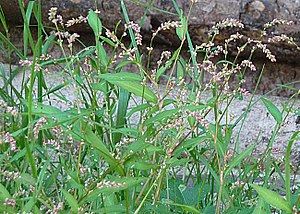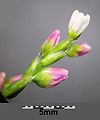Mild knotweed
| Mild knotweed | ||||||||||||
|---|---|---|---|---|---|---|---|---|---|---|---|---|

Mild knotweed ( Persicaria dubia ) |
||||||||||||
| Systematics | ||||||||||||
|
||||||||||||
| Scientific name | ||||||||||||
| Persicaria dubia | ||||||||||||
| closet |
The mild knotweed ( Persicaria dubia (stone) Fourr. , Syn .: Polygonum mite closet , Persicaria mitis (closet) Assenov non Delarbre , Persicaria laxiflora Opiz ) belongs to the knotweed genus ( Persicaria ) in the knotweed family (Polygonaceae).
description
The mild knotweed is an annual herbaceous plant . The medium green leaves have distinct side veins. Stipule sheaths ciliate on the edge 3 to 6 mm long, hairy on the surface.
The false ear is curved or nodding. The flowers are usually five-fold. The bracts are green below, white, pink or red above, glandless or with only a few glands. There are six stamens . The fruits are lenticular or triangular, shiny, black nuts that are 2.5 to 3.5 mm long.
The number of chromosomes is 2n = 40 or 44.
photos
Locations
The mild knotweed occurs scattered in ephemeral pioneer weed meadows on banks, ditches, springs, damp forest paths. It prefers loam and clay soils, but also goes on muddy soils. Because of its need for warmth, it only climbs up to around 1000 m in particularly warm Alpine valleys. In the lowlands he is z. Sometimes rarely, otherwise scattered. Is absent in rough locations, both in the lowlands and in the low mountain ranges, where it hardly exceeds 700 meters above sea level.
Although it has generally been in decline since the 20th century, it has, on the other hand, experienced significant local support through the creation of forest trails. This creates additional inner forest fringes on which the species spreads; In addition, there is often a favorable eutrophication of the forest edges by the introduction of calcareous rocks.
According to Ellenberg , it is a semi-light plant that prefers nitrogen-rich locations and a class character of the two-toothed muddy banks ( Bidentetea ), according to Oberdorfer even a character type of the order Bidentetalia.
Name declaration
The term mild knotweed refers to the fact that the leaves of the plant do not taste sharp when chewed, as is the case with the similar water pepper ( Persicaria hydropiper ). The species does not contain the sharp-tasting, weakly poisonous essential oil that gave water pepper its name.
Individual evidence
- ↑ a b Erich Oberdorfer : Plant-sociological excursion flora for Germany and neighboring areas . 8th edition. Verlag Eugen Ulmer, Stuttgart 2001, ISBN 3-8001-3131-5 . Page 338.
Web links
- Persicaria mitis (cupboard) Assenov non Delarbre 1800, Milder Knöterich. In: FloraWeb.de.
- Profile and distribution map for Bavaria . In: Botanical Information Hub of Bavaria .
- Polygonum mite closet In: Info Flora , the national data and information center for Swiss flora . Retrieved October 7, 2015.
- Thomas Meyer: Data sheet with identification key and photos at Flora-de: Flora von Deutschland (old name of the website: Flowers in Swabia )
- Photos.





